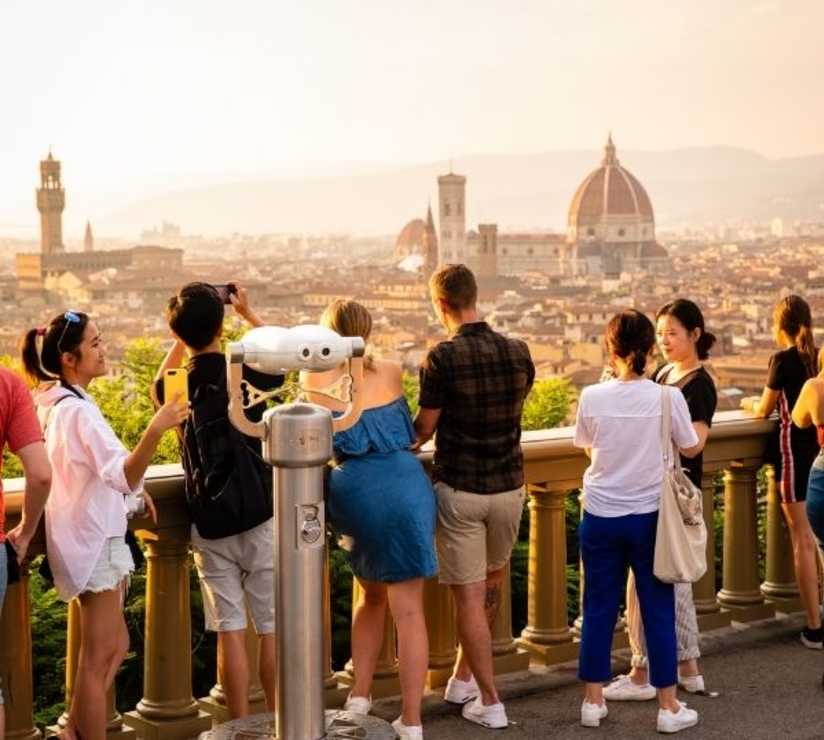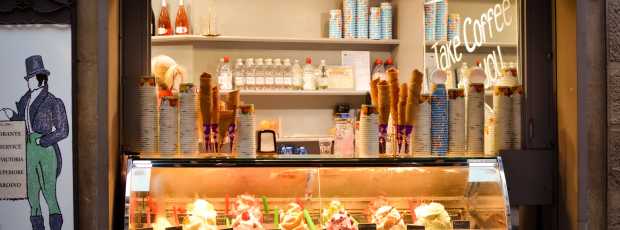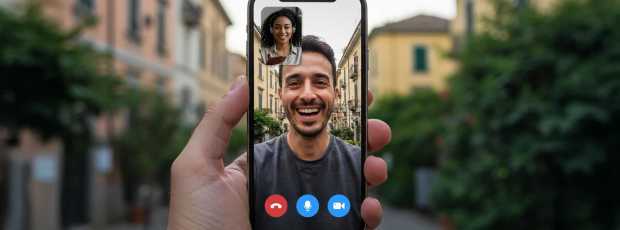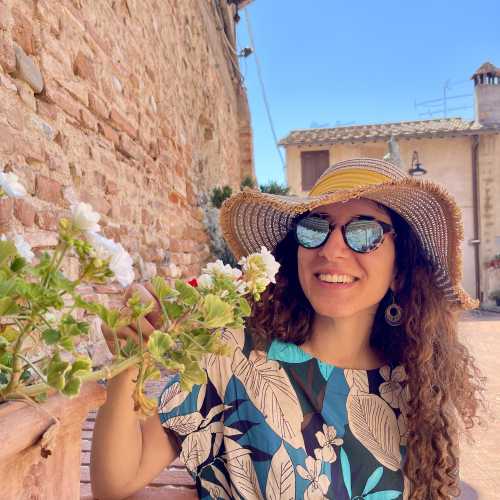Table Of Contents
- A City Best Tasted, Not Toured: Discovering Florence Through Its Food
- Signature Dishes And Local Classics You'll Smell Before You See Them
- Global Influences And Immigrant Tables That Now Feel Florentine
- Street Food And Everyday Bites That Keep The City Moving
- Sweet Treats And Afternoon Escapes For When You Need A Pause
- What Locals Drink And When: Coffee At Dawn, Wine By Dusk, Amaro After Dark
- Where To Eat: Markets, Trattorias, And Corners That Still Feel Local
- Florence's Food Traditions Through The Seasons
- Overrated Food Experiences (And What To Eat Instead)
- Practical Tips On What To Eat In Florence
- Frequently Asked Questions On What To Eat In Florence
- Eat Well, Come Back Often: How Florence Remembers You
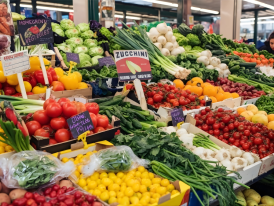
Early morning Sant'Ambrogio Market with fresh produce
What to eat in Florence isn't a checklist. It's about knowing when the porchetta van arrives at the market, which trattoria makes ribollita worth ordering, and why lampredotto from a street cart tastes better than anything plated on white linen. In this guide, I'll show you what we eat, where we go when we're hungry (not when we're performing), and how to navigate this city's food culture without falling into the obvious traps. Florence runs on olive oil, bread, and stubborn pride. If you're looking for authentic Florence experiences, they start at the table. The rest is just detail.

Morning light over Sant'Ambrogio Market with vendors setting up produce
A City Best Tasted, Not Toured: Discovering Florence Through Its Food
Most people arrive with a list: Duomo, Uffizi, Ponte Vecchio, done. But Florence's heart beats loudest in kitchens where pots clang and grandmothers argue about salt. The best restaurants in Florence aren't the ones with English menus facing Piazza della Signoria. They're the ones where locals elbow each other at shared tables in the Oltrarno District, or queue outside Sant'Ambrogio Market for lunch-only spots that close by 2 PM, or drink wine standing at marble counters in San Lorenzo while debating last night's football match.
Food culture here isn't performance. It's ritual, argument, and memory baked into every loaf. If you love eating, you'll understand Florence immediately. If you eat to fuel sightseeing, you'll miss the entire point of being here. The city doesn't reveal itself through monuments. It reveals itself through flavour, through the way bread soaks up ribollita, through the char on a bistecca alla fiorentina, through the cold shock of gelato eaten in January because you wanted it, and that's reason enough. When people ask about things to do in Florence, eating well should be at the top of that list.
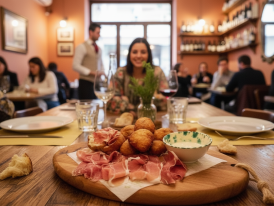
Golden fried coccoli on a plate with creamy stracchino cheese and wine glass
Signature Dishes And Local Classics You'll Smell Before You See Them
Florence runs on simple, proud plates that don't apologize for being exactly what they are. These dishes tell you everything about the city's stubborn refusal to modernize for the sake of it.
Ribollita: The Soup That Refuses To Die
Ribollita is what happens when you refuse to waste bread. It's one of the most Florentine things you can eat. This twice-cooked soup combines leftover vegetables, beans, and stale bread into something thick enough to hold a spoon upright. It tastes like winter even when it's not cold outside, and the best versions come from places that don't overthink it.
I eat Trattoria Sabatino's ribollita at least twice a month in winter. The bread melts into the broth until you can't tell where one ends and the other begins. They finish it with olive oil so green it stains the bowl. It's not pretty. It's perfect. Order it, eat it slowly with house wine. Expect about €10 to €20 per person at lunch only classics like Sabatino. This is Tuscan cuisine at its most honest, and it's one of the best food experiences in the city.
Lampredotto: The Sandwich With A Soul
Lampredotto is cow stomach simmered in broth until it's tender, then sliced thin and stuffed into a roll. It sounds strange until you taste it. Then it tastes like Florence. This is street food at its most honest, sold from carts around the city centre and historic centre by vendors who've perfected the recipe over decades. The sandwich comes dipped in cooking broth, topped with salsa verde or hot sauce, and handed to you wet and dripping.
The first time I tried lampredotto, I was 11 years old and my uncle dragged me to a cart near Sant'Ambrogio. I was horrified by the concept. Now I crave it at least once a week. It's soft, savoury, and completely addictive once you get past the idea of what you're eating. €4 to €7 for a sandwich, depending on stall and extras. Eat it standing up, wipe your chin, and stop overthinking food.
Bistecca Alla Fiorentina: Fire, Salt, And Simplicity
The Fiorentina steak is Florence's most famous dish, and it deserves the reputation. This is a massive t-bone cut from Chianina cattle, grilled over hot coals, and served rare with nothing but salt and a drizzle of olive oil. A proper bistecca alla fiorentina weighs at least a kilo and feeds two people, though I've watched my partner attempt one solo more than once.
Il Santo Bevitore serves steak simply brushed with olive oil and rosemary, and it's excellent. Trattoria Da Ruggero near Porta Romana (Oltrarno) cooks theirs over wood and serves it on cutting boards with nothing else, which is the correct approach. Trattoria Sostanza is legendary for its butter-rich classics, and while steak appears on the menu, most locals crowd the room for the pollo al burro. Book ahead if you're serious about steak. Arrive early if you're not. Pair it with Chianti Classico and never ask for it well done. The kitchen will remember you, and not fondly. Reputable places will show you the steak's weight and breed or origin before cooking.
Pappa Al Pomodoro: The Taste Of Leftovers Done Right
Pappa al pomodoro sits somewhere between soup and porridge, and it tastes like summer compressed into a bowl. Tomatoes, garlic, basil, stale bread, olive oil. That's it. The texture is soft, almost baby-food soft, but the flavour is bright and sharp enough to wake you up. Good pappa al pomodoro depends entirely on quality ingredients: ripe tomatoes that taste like something, bread that was worth eating when it was fresh, and oil that hasn't been sitting in a plastic bottle for two years.
Most restaurants in Florence serve it year-round, but I only order it in late summer when tomatoes are so ripe they're almost falling apart. The rest of the year, it tastes like nostalgia for a season that isn't here yet. Eat it with a glass of cold white wine and bread on the side, even though bread is already in the dish. That's not redundant. That's Tuscan.
Coccoli And Stracchino: Fried Joy At Aperitivo Hour
Coccoli are small fried dough balls, crispy outside and pillowy inside, served with stracchino cheese and thin-sliced salami. They're the opposite of elegant, and they're perfect with pre-dinner drinks at any wine bar in Santo Spirito or near Santa Croce. This is how Florence does aperitivo when it's not trying to impress tourists with Instagram boards piled high with mediocre cheese.
I order coccoli at least once a week, usually at a wine bar on Via Maggio where they serve them hot enough to burn your tongue and don't charge an extra cost for more stracchino. Pair them with a glass of wine, settle in for people watching, and remember that aperitivo is about unwinding, not photographing your snacks. These small bites with good wine are what Florence's finest aperitivo culture looks like.
Cantucci And Vin Santo: The Sweet Goodbye
Cantucci are almond biscuits, hard and dry, made specifically for dunking in vin santo, a sweet dessert wine that tastes like honey and regret. This is how meals end in Florence. Not with fanfare, but with a small ritual of dipping and sipping that slows everything down. You'll find this pairing at the end of most dinners, sometimes on the house, sometimes for a small extra cost. Either way, take your time. Vin santo is strong and sticky-sweet, and cantucci soften just enough to be good without disintegrating into mush.
Looking for a private city experience in Florence?
Explore the city with a local who plans a private day just for you; no groups, no scripts.

Steaming dumplings in bamboo baskets on a worn wooden table
Global Influences And Immigrant Tables That Now Feel Florentine
Florence's kitchens whisper more than Italian these days. Walk the right streets and you'll hear Arabic, Albanian, Chinese, and Senegalese voices calling orders, stirring pots, and feeding the city food that's become part of the everyday rhythm. Florence's food scene has expanded beyond Tuscan classics to include flavours that now feel at home here.
Sant'Ambrogio Market isn't just vegetables and cheese anymore. The streets around it hold Lebanese and Turkish spots serving shawarma and falafel that students and workers queue for at lunch. Via Palazzuolo and the streets behind the train station have a strong West African presence, with small restaurants serving thieboudienne and mafe that taste like someone's home cooking because they are. The Chinese restaurants tucked into San Lorenzo's side streets serve hand-pulled noodles and soup dumplings to families and night workers who know where to eat when everything else shuts down. These places open late and close later, and the delicious food is better than half the Italian restaurants charging triple the price.

Freshly baked pizza al taglio with rosemary and olive oil
Street Food And Everyday Bites That Keep The City Moving
Most of us eat standing up more often than sitting down. It's faster, cheaper, and somehow tastes better when you're not performing the ritual of a full meal. Florence's street food culture runs deep, and these are the bites that keep us moving.
Trippaio Carts: Florence's Fast Food
Tripe carts (trippaio) are scattered around Florence, usually near markets or busy piazzas, serving lampredotto, tripe, and other offal sandwiches to workers and students who don't have time for a sit-down lunch. The vendors work fast, the food is cheap, and the flavour is pure. Don't expect outdoor seating or WiFi. Just good food handed to you in paper, ready to eat immediately or never.
Schiacciata Sandwiches: Crunch Meets Comfort
Schiacciata is Tuscan flatbread, salty and crisp, split open and filled with whatever you want: prosciutto, pecorino, mortadella, arugula. The bread does most of the work here. When it's fresh from the oven, it's one of the best paninis you'll ever eat. Every bakery makes schiacciata differently. Some add rosemary, some keep it plain, some drench it in oil. My favourite comes from a bakery near Piazza Santo Spirito that bakes twice daily and sells out by 2 PM. The crust shatters when you bite it, and the inside stays soft enough to soak up oil and tomato without falling apart.
Porchetta At Markets And Counters
Porchetta is slow-roasted pork, herb-stuffed and crispy-skinned, carved thick and stuffed into a roll. You'll find porchetta shops and market counters (and occasional trucks at fairs and markets) serving sandwiches hot, juicy, and wrapped in wax paper. This is eat-on-the-move food, perfect for when you're walking between neighbourhoods and don't want to stop for a full meal. The meat is rich enough to need nothing but bread and maybe a squeeze of lemon if you're feeling fancy.
Late-Night Pizza Al Taglio Windows
Pizza al taglio (pizza by the slice) shops stay open late, serving thick rectangular slices topped with potato and rosemary, zucchini flowers (fiori di zucca), or simple tomato and basil. The best pizza comes hot from the oven, weighed, cut, and handed to you in minutes. These places don't do atmosphere. They do fast, hot, delicious food that tastes better at midnight than it has any right to.

Locals standing at espresso bar counter with barista pulling shots in morning light
Sweet Treats And Afternoon Escapes For When You Need A Pause
Florentines don't rush their sugar. Gelato is both therapy and tradition, and we take both seriously. The afternoon pause for something sweet isn't indulgence here, it's part of the daily rhythm, a moment to slow down between errands and obligations.
Seasonal Gelato Flavours Worth The Queue
The best gelato in Florence doesn't come from shops on the main tourist routes. It comes from small places where flavours change with the season and nothing looks artificially perfect. Look for gelato with muted colours and natural textures. If the pistachio is neon green, keep walking. If the salted caramel looks pale and grainy, you're in the right place. I have a gelato shop near Santo Spirito that makes a fig and ricotta in autumn that tastes like dessert and breakfast combined. Find your own favourite and guard it closely. This is how food lovers experience Florence's sweet side.
Old Pastry Shops That Still Dust Their Own Sugar
Florence has pastry shops that have been here longer than most of the restaurants. They make cantucci, ricciarelli, and biscotti della nonna by hand, and they don't change recipes to suit trends or tourists. These shops smell like butter and almonds. The counters are worn marble. The owners remember regulars' orders. This is where you go when you want something sweet that feels like home, even if it's not yours.
Coffee Bars Where Locals Argue Over Foam Ratios
Coffee in Florence is serious business. Morning espresso is taken standing at the bar, fast and hot. The best coffee comes from small bars where regulars have their spot, the barista knows their order without asking, and the foam on a cappuccino is thick enough to hold a sprinkle of cocoa without collapsing. Coffee mantra applies here: one drink, one moment, no lingering. Drink it, pay, leave. The entire transaction takes less than three minutes, and that's exactly how long it should take.
What if your day in Florence was planned by someone who knows it — and you?
City Unscripted matches you with a local host who creates a private experience based on your interests, not a set route.

Glasses of wine and wine bottles lined up on a rustic bar counter
What Locals Drink And When: Coffee At Dawn, Wine By Dusk, Amaro After Dark
Florence knows its hours: espresso in the morning, wine by sunset, amaro after dinner. Deviate at your own risk. These aren't arbitrary rules, they're the city's internal clock, and if you order a cappuccino at 3 PM, the barista won't refuse you, but they'll remember. Understanding what to drink and when is as essential to eating well here as knowing where to sit or how to order.
Morning Rituals: Standing Espresso At The Bar
Morning coffee is a standing affair. You walk in, order an espresso, drink it in two sips, pay, and leave. This is how the city wakes up. Standing (al banco) is cheaper than sitting (al tavolo). If you order a latte, you'll get a glass of milk. Cappuccino is fine until about 11 AM. After about 11 AM, most locals switch to espresso. Milk drinks are a breakfast convention, not a rule.
Aperitivo Culture: Snacks, Gossip, And Spritzes Done Right
Aperitivo in Florence isn't about endless buffets or elaborate Instagram boards. It's a glass of wine, small bites (olives, cheese, crostini), and an hour of unwinding before dinner. Wine bars in Santo Spirito and around Santa Croce do this well without trying too hard. They serve simple snacks and pour good wine. The vibe is casual enough that you can show up alone or with eight people, and no one cares either way.
Evening Wines: Chianti, Vin Santo, And The Occasional Vermouth
Wine flows through Florence like water. Chianti is the default, poured freely at lunch and dinner, and no one judges you for drinking it young and cheap from a carafe. Wine bars stock Tuscan classics alongside natural wines and small-batch vermouths. A wine tour through the city centre will take you to spots where staff pour generously and talk you through every bottle without sounding pretentious or rehearsed.
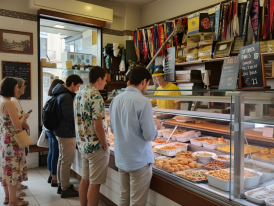
Small deli counter with salami hanging and owner making sandwiches for waiting customers
Where To Eat: Markets, Trattorias, And Corners That Still Feel Local
The heart of Florence beats loudest where you hear plates clatter and gossip hum over the sound of wine being poured. These are the only places worth your time.
Mercato Centrale: The City's Pantry
Mercato Centrale has two faces. The ground floor is a working market with butchers, bakers, and vegetable stalls that locals use daily. The upper floor is a food hall with stands serving everything from pasta to sushi. The ground floor is where you want to be. Buy fresh ingredients, eat a sandwich at one of the no-frills counters, and watch how Florentines shop. This is real life, not a tourism set.
Sant'Ambrogio Market: My Everyday Reality
Sant'Ambrogio Market is smaller, scrappier, and more local than Mercato Centrale. It's where I buy vegetables, cheese, and gossip in equal measure. The stalls close by 2PM, so arrive early if you want the good stuff. There's a trattoria inside the market (Trattoria Da Rocco) that's lunch only and open to everyone, packed with vendors and locals. The menu changes daily based on what's available, the portions are massive, and the food tastes like someone cooked it because they love you, not because you paid them.
Oltrarno: Where Florentines Still Eat Among Florentines
The Oltrarno District is the other side of the river, and it still feels like a neighbourhood instead of a postcard. Streets like Via di Santo Spirito and around Piazza Santo Spirito have wine bars, trattorias, and small restaurants that locals defend fiercely against gentrification and tourist menus. Il Santo Bevitore is one of the best restaurants here, serving Florentine cuisine with a lighter hand and a menu that shifts with the seasons. I go there for a special night when I want to eat well without the theater of fine dining. The space is small, the food is consistently excellent, and the wine list is long enough to get lost in.
Hidden Trattorias Near Santo Spirito
Trattoria Sergio Gozzi near San Lorenzo is a lunch only spot where workers eat fast and cheap. The menu is handwritten daily, the tables are shared, and the food is exactly what you'd expect from a place that's been here for decades: simple, filling, and good. English is limited. You point, they serve, you eat, you pay, you leave. The entire meal costs €12 to €15 including wine. Trattoria Mario nearby follows the same no frills approach.
Trattoria Da Ruggero near Porta Romana (Oltrarno) is louder, more chaotic, and packed with locals who come for the bistecca alla fiorentina and stay for the house wine poured from unmarked bottles. No English menu. No pretense. Just food that tastes like it was made by someone's mother, which it might be. These traditional trattorias show you what local history tastes like.
Family-Run Deli Counters And Tiny Taverns
Florence is full of small spots that don't advertise: deli counters that make sandwiches to order, tiny taverns that serve lunch to five tables and close by 3 PM, corner bars that pour wine and serve cheese on marble counters. These places don't have websites or Instagram accounts. You find them by walking, by asking, or by getting lost and stumbling in. When you do, they're better than anything you researched in advance. These are the hidden gems in Florence that make the city feel like home.
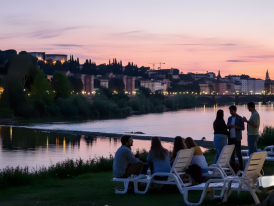
Riverside picnic spread with bread, cheese, melon, prosciutto, and wine bottle
Florence's Food Traditions Through The Seasons
Food in Florence is measured by the season, not by trends. What you eat depends on when you're here, and the rhythm of the city is reflected in every meal. From hearty winter stews to the light, fresh dishes of spring, Florence’s food culture shifts in harmony with the changing seasons. Here's how the city’s relationship with food evolves throughout the year.
Winter: Warmth and Comfort for the Soul
Winter in Florence is all about rich, hearty meals designed to warm you up from the inside out. With the cold air sweeping through the city, the food becomes more indulgent and comforting. It’s the season to slow down and enjoy food that nourishes both body and soul.
- Ribollita: a thick, vegetable-packed soup made with stale bread, beans, and greens, is a staple during the winter months.
- Wild boar stew and roasted chestnuts are found on many menus and sold from street vendors, filling the air with comforting aromas.
- Truffles make their appearance, shaved over pasta or scrambled eggs, adding a luxurious touch to winter dishes.
- Hearty meals like these are best enjoyed slowly with a glass of Chianti or a rich, full-bodied red wine.
Spring: A Time for Freshness and New Beginnings
As spring arrives, Florence awakens with fresh, light flavours that herald the new season. The markets burst with fresh produce, and the outdoor terraces start to fill up as the city enjoys longer, warmer days.
- Crispy artichokes and raw broad beans paired with pecorino cheese signal the arrival of spring’s first produce.
- Young wine, still a little fizzy, is poured freely, accompanying meals that begin to lighten up.
- Fresh asparagus and peas become the stars of the market, while strawberries make a brief but much-anticipated appearance.
- Menus shift toward lighter, brighter dishes that focus on the simplicity and freshness of the ingredients.
Summer: Simple, Refreshing Meals for Hot Days
Summer in Florence is slow and hot, and the food reflects the need for refreshing, easy-to-eat dishes. Meals are lighter and often enjoyed outdoors, making the most of the city’s warm, sunny weather.
- Cold melon with prosciutto is a favourite, with its perfect balance of sweet and salty.
- Pappa al pomodoro is served at room temperature, a cool, light dish made of tomatoes, stale bread, and olive oil.
- Gelato is enjoyed throughout the day, with locals indulging in it multiple times as a way to cool off.
- Instead of sitting down for a formal meal, many Florentines prefer to buy fresh produce from the market and eat it by the river, bread, cheese, wine, and whatever fruit looks good at the moment.
Autumn: The Season of Rich Flavours and Long Meals
As the heat of summer fades, autumn brings a new depth of flavour to Florence’s food scene. It’s a time for indulgent, earthy dishes that celebrate the harvest and the changing weather.
- Porcini mushrooms take centre stage, with dishes that include them grilled, fried, or folded into pasta.
- New wine begins to pour, marking the start of the grape harvest, and the city’s wine bars offer a fresh selection of local wines.
- Wild boar stew and other hearty, slow-cooked dishes return to menus, bringing warmth and richness to the table.
- Chestnuts, pumpkins, and squash start to appear in markets, perfect for roasting and adding to seasonal dishes.
- Autumn is the time to embrace long, leisurely meals, enjoying the changing weather and the abundance of seasonal produce.
Tip
We match you with the right host, not just any guide.Want to experience the real Florence with someone who lives there?
A fully private experience, planned and led by a local host who tailors the day to you

Simple aperitivo spread with olives, cheese, and wine at a neighborhood bar
Overrated Food Experiences (And What To Eat Instead)
Some spots earn their fame honestly. Others coast on location and tourist traffic. Here's the truth, compared to what you'll find in other cities.
Piazza Della Signoria Gelato: Skip Unless You're Desperate
Gelato shops facing Piazza della Signoria are overpriced, overcrowded, and average at best. The gelato isn't terrible, but you're paying double for the view. The view isn't even that good when you're surrounded by tour groups. Walk five minutes in any direction and you'll find better gelato for half the price.
Tourist Menus Around The Duomo: Just Don't
Any restaurant with laminated menus in five languages and photos of the food near the Duomo is playing to tourists, not feeding locals. The food is safe, bland, expensive, and forgettable. Instead, walk 10 minutes to Trattoria Mario or Trattoria Sergio Gozzi. Both are lunch only, both serve workers and students, and both have better food for half the price.
High-End Pasta Labs: Try A Family Trattoria Instead
Florence has a few high-end restaurants where pasta comes in tiny portions with tweezers and foam. They're fine if you're into that, but they're not what this city is about. If you want a special night out, go to Il Santo Bevitore or Vini e Vecchi Sapori. Both serve excellent food without the theater. You'll leave full and satisfied instead of confused and still hungry.
Instagram Aperitivo Boards: Go For Simple Coccoli Instead
Aperitivo boards piled high with cured meats and cheese look great in photos, but they're often pre-made hours earlier and overpriced for what you get. Real aperitivo is a glass of wine, a small plate of olives or coccoli, and conversation. Find a wine bar that locals use. Drink what they pour. Eat what they serve. Skip the board designed for cameras.
Practical Tips On What To Eat In Florence
Eating well in Florence is more about rhythm than rules. Slow down, listen for clinking glasses, and follow the smell. It never lies.
- When to eat: Breakfast is small (coffee and a pastry by 9 AM). Lunch runs from 12:30 PM to 2:30 PM. Many restaurants close after lunch and don't reopen until 7 PM. Dinner starts at 7:30 PM or 8 PM. Most traditional kitchens wind down around 10:30 PM to 11 PM. Late options skew to pizza al taglio and a few ethnic spots.
- How to order: Menus follow a structure: antipasti, primi (pasta or soup), secondi (meat or fish), contorni (sides), dolci (dessert). You don't have to order every course. Most locals skip starters and go straight to pasta and meat, or just eat pasta. Handwritten menus mean the kitchen is cooking what's fresh.
- Tipping: Most places add a coperto (€1 to €3) for the table setting (often with bread). Servizio may be added separately. Tipping is optional. Round up a euro or two for great service.
- Queues and bookings: Popular spots like Trattoria Mario get queues. Arrive early (by 12:30 PM for lunch, 7:30 PM for dinner) or wait. Some restaurants don't take reservations. Others require restaurant bookings days in advance. Have a backup plan.
- Dietary needs: Most restaurants offer gluten-free pasta and vegetarian options. Ribollita and pappa al pomodoro are naturally vegetarian. Vegan options are harder but possible. Ask for dishes without cheese or butter.
- Markets vs. supermarkets: Markets sell what's in season, and that's what tastes good. Supermarkets stock everything year-round, but quality is inconsistent. For picnic supplies, markets win every time.
Frequently Asked Questions On What To Eat In Florence
1) What is the most traditional dish to eat in Florence?\ Bistecca alla fiorentina is iconic, but ribollita and pappa al pomodoro are more historically rooted in Florence's food culture.
2) Where do locals usually go for lunch in Florence?\ Trattoria Sergio Gozzi, Trattoria Sabatino, and small places inside Sant'Ambrogio Market. Look for handwritten menus and shared tables.
3) Is it safe to eat lampredotto in Florence?\ Yes. It's a cow's stomach cooked tender in broth. It's been a street food staple for generations.
4) How much should you expect to spend when eating out in Florence?\ Traditional trattorias: €15 to €25 per person. High-end restaurants: €40 to €80 or more. Street food: €5 to €8.
5) When is the best time to visit the markets in Florence for fresh produce?\ Markets open around 7 AM and close by 2 PM. Arrive by 10 AM for the best selection.
6) What dishes are seasonal in Florence throughout the year?\ Truffle dishes (autumn), zucchini flower paccheri (spring and summer), wild boar stew (winter), ribollita (winter).
7) Are there vegetarian food options in Florence?\ Ribollita, pappa al pomodoro, and most vegetable-based antipasti work. Newer spots around Santo Spirito cater more to plant-based diets.
8) What desserts is Florence most famous for?\ Cantucci, schiacciata alla fiorentina, and gelato. Florence doesn't do heavy desserts.
9) Is it possible to find places to eat late at night in Florence?\ Most kitchens close by 11 PM. Late-night options: pizza al taglio shops, Chinese restaurants near San Lorenzo, and a few bars serving snacks until midnight.
10) What is the difference between a trattoria and an osteria in Florence?\ Historically, trattorias serve home-style food. Osterias focus on wine with food as backup. The terms are now used interchangeably.
11) What wine is considered the best pairing for steak in Florence?\ Chianti Classico. The tannins cut through the fat.
12) What is the proper coffee etiquette when ordering coffee in Florence?\ Espresso or cappuccino, standing at the bar, finished in two minutes. Milk drinks are for mornings only.
13) How can you spot a tourist trap when eating in Florence?\ Photos on the menu, staff waving you in from the street, prices in multiple currencies, location directly on Piazza della Signoria or Piazza della Repubblica, or next door to major monuments on Via Dei Neri.
Ready to plan your perfect day in Florence?
Start your experience
Locals laughing over shared meal at marble counter with house wine and empty plates
Eat Well, Come Back Often: How Florence Remembers You
The best meals in Florence aren't photographed. They're eaten standing up at marble counters, or shared at tables with strangers who become friends over house wine, or grabbed from carts while walking between piazzas. They taste better because they're real, because no one's performing, because the food matters more than the setting.
Florence doesn't perform for you. It feeds you if you're willing to slow down, pay attention, and eat what we eat: the ravioli stuffed with ricotta at a no-name trattoria, the lampredotto from a cart near the market, the gelato that doesn't look perfect but tastes like summer. Food tours will show you highlights. Walking alone will show you the rest. Both are worth your time, but only one will make you feel like you've tasted Florence as it is, not as it's sold to tourists who leave the next day. This is how you experience the best of Italy experiences through food.
This city runs on flavour and familiarity. Take your time. Arrive early. Book ahead when it matters. Eat what's in season. Drink what's local. Ask questions. Share tables. Follow your nose. When someone offers you bread dipped in oil, always say yes. That's how you eat Florence, and that's how Florence remembers you.
What if your day in Florence was planned by someone who knows it — and you?
City Unscripted matches you with a local host who creates a private experience based on your interests, not a set route.
Want to experience the real Florence with someone who lives there?
A fully private experience, planned and led by a local host who tailors the day to you
Meet Your Florence Hosts
Eat Well, Come Back Often: How Florence Remembers You
The best meals in Florence aren't photographed. They're eaten standing up at marble counters, or shared at tables with strangers who become friends over house wine, or grabbed from carts while walking between piazzas. They taste better because they're real, because no one's performing, because the food matters more than the setting.
Florence doesn't perform for you. It feeds you if you're willing to slow down, pay attention, and eat what we eat: the ravioli stuffed with ricotta at a no-name trattoria, the lampredotto from a cart near the market, the gelato that doesn't look perfect but tastes like summer. Food tours will show you highlights. Walking alone will show you the rest. Both are worth your time, but only one will make you feel like you've tasted Florence as it is, not as it's sold to tourists who leave the next day. This is how you experience the best of Italy experiences through food.
This city runs on flavour and familiarity. Take your time. Arrive early. Book ahead when it matters. Eat what's in season. Drink what's local. Ask questions. Share tables. Follow your nose. When someone offers you bread dipped in oil, always say yes. That's how you eat Florence, and that's how Florence remembers you.
